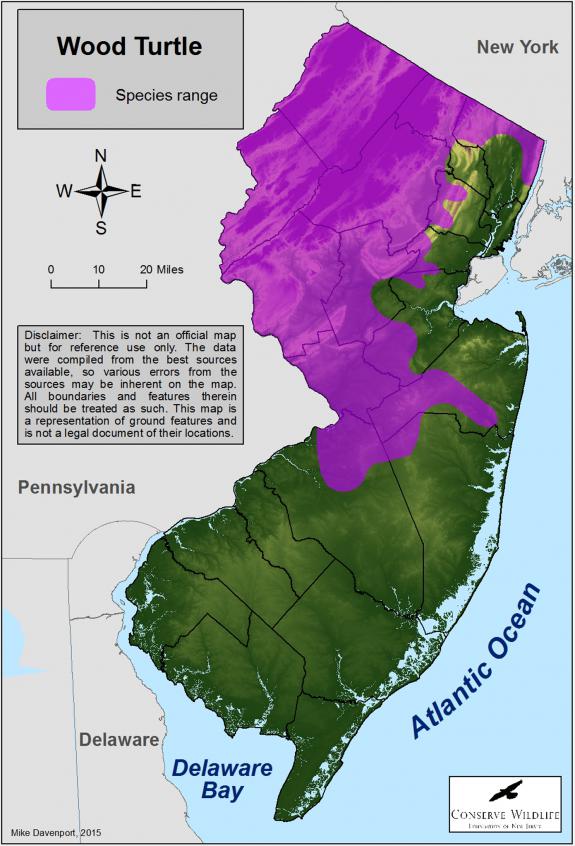Glyptemys insculpta
Type: reptile
Status: threatened
Species Guide
Wood turtle
Glyptemys insculpta
Species Type: reptile
Conservation Status: threatened
Identification
The wood turtle’s carapace, or upper shell, has a sculpted or grooved appearance. Each season a new annulus, or ridge, is formed, giving each scute (a scale-like horny layer) a distinctive pyramid-shaped appearance. As the turtle ages, natural wear smoothes the surface of the shell. While the scutes of the carapace are brown, the plastron, or underneath shell, consists of yellow scutes with brown or black blotches on each outer edge. The legs and throat are reddish-orange. The male wood turtle has a concave plastron while that of the female is flat or convex. The male also has a thicker tail than the female. Adult wood turtles measure 5.5 to 8.0 inches in length.

Distribution & Habitat
The wood turtle is found in eastern North America, ranging from Nova Scotia in the south to Virginia in the south and from the easternmost US states to Minnesota in the west. In New Jersey, the range is primarily limited to the northern and central portions of the state, although there have been a few occurrences within the Pine Barrens.
Wood turtles historically inhabited nearly all counties in northern and central New Jersey. However, habitat loss has restricted their distribution to disjunct populations associated with particular drainages. The largest populations in the state currently exist in Hunterdon, Morris, Sussex, Passaic, and Warren counties.
Unlike other turtle species that favor either land or water, the wood turtle resides in both aquatic and terrestrial environments. Aquatic habitats are required for mating, feeding, and hibernation, while terrestrial habitats are used for egg laying and foraging.
Freshwater streams, brooks, creeks, or rivers that are relatively remote provide the habitat needed by these turtles. Wood turtles are often found within streams containing native brook trout. These tributaries are characteristically clean, free of litter and pollutants, and occur within undisturbed uplands such as fields, meadows, or forests. Open fields and thickets of alder, greenbrier, or multiflora rose are favored basking habitats. Lowland, mid-successional forests dominated by oaks, black birch, and red maple may also be used. Wood turtles may also be found on abandoned railroad beds or agricultural fields and pastures.
Wood turtle habitats typically contain few roads and are often over one-half of a mile away from developed or populated areas. Individuals from relict or declining populations are also sighted in areas of formally good habitat that have been fragmented by roads and development.
Diet
An omnivorous species, the wood turtle consumes a variety of animal and plant matter. Insects and their larvae, worms, slugs, snails, fish, frogs, tadpoles, crayfish, and carrion are included in their diet. In addition, these turtles forage on leaves, algae, moss, mushrooms, fruit, and berries.
Life Cycle
During early March, wood turtles emerge from hibernation and bask along stream banks. Breeding activity begins as water temperatures warm to about 59°F. The turtles mate within streams during April and, by mid-May, move to dry land, where they will spend the next several months. Females seek elevated, well-drained, open areas where they can dig their nests. Nests are often excavated at depths of 3.5 – 4.5 inches.
The female wood turtle lays a clutch of eight to nine smooth, white eggs which hatch in about 70 to 71 days. The eggs, hatchlings, and adults may fall prey to raccoons or skunks. Hatchling wood turtles are 1.5 inches in length and are distinguished by their long tails, which can be nearly equal in length to the carapace. If the young turtles survive, they can live 20 to 30 years, reaching sexual maturity in their fourteenth year.
During the summer months, adult wood turtles wander along stream corridors while foraging in open fields and woodlands. In New Jersey, marked wood turtles have been observed at locations up to 0.56 miles from their wintering streams. One turtle traversed nearly 1 mile within two months. The turtles are especially vulnerable to being struck and killed by automobiles while crossing roads during this nomadic period.
Wood turtles return to streams and creeks and begin hibernating by late November. They winter in muddy stream bottoms, within creek banks, or in abandoned muskrat holes. Individuals may overwinter in the same stream or embankment during successive years.
Current Threats, Status, and Conservation
Historically, the wood turtle was a fairly common species within suitable habitat in New Jersey. By the 1970s, however, declines were noted as wood turtles were absent from many historic sites due to habitat loss and stream degradation. Because of this, the wood turtle was listed as a threatened species in New Jersey in 1979.
Since the late 1970s, biologists have monitored and surveyed wood turtle sites in New Jersey, providing valuable data regarding the life history, reproduction, and habitat use of these turtles in the state. There is, however, a continuing need to examine the productivity and juvenile survival of wood turtles, which may be threatened by disturbance or predation. The New Jersey Endangered Species Act prohibits the collection or possession of wood turtles. However, collecting of wood turtles as pets continues to be a problem which may result in reduced population size or the loss of local populations.
References
Text derived from the book, Endangered and Threatened Wildlife of New Jersey. 2003. Originally edited by Bruce E. Beans and Larry Niles.
Edited and updated Michael J. Davenport in 2010.
Scientific Classification
- Kingdom: Animalia
- Phylum: Chordata
- Class: Reptilia
- Order: Testudines
- Family: Emydidae
- Genus: Glyptemys
- Species: G. insculpta